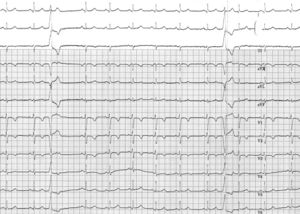Puzzle 2007 1 33 Answer
| Author(s) | A.A.M. Wilde | |
| NHJ edition: | 2007:01,033 | |
| These Rhythm Puzzles have been published in the Netherlands Heart Journal and are reproduced here under the prevailing creative commons license with permission from the publisher, Bohn Stafleu Van Loghum. | ||
| The ECG can be enlarged twice by clicking on the image and it's first enlargement | ||
A 38-year-old male patient presents with palpitations. He is not suffering from syncope or dizziness and has no other complaints. The family history bears no peculiarities. Physical examination of the heart reveals an irregular heart beat. Auscultation is normal and there are no signs of left or right heart failure. The ECG is depicted in figure 1.
What is your diagnosis and should there be any further investigation?
Answer
The ECG shows sinus rhythm with a mean rate of 60 beats/min. There is some sinus arrhythmia present. Conduction intervals are normal (PR 150 ms, QRS 90 ms). Repolarisation abnormalities are present in the right precordial leads V1 to V3 (terminal negative T waves) and the ST-T segment in lead V4 is flat.
Two wide complexes are seen, the third and tenth QRS complex. Both share a similar morphology with a left bundle branch block and an almost vertical axis. There is no discernible P wave prior to these wide QRS complexes and the first is followed by a complete compensatory pause in contrast to the second which does not influence the underlying sinus rhythm. The morphology of the wide complexes, the lack of P waves and the presence of a complete compensatory pause all point to a ventricular origin of this activity. Based on the morphology, an origin in the right ventricular outflow track (RVOT) is likely. In combination with the ST-T segment abnormalities one should consider arrhythmogenic right ventricular dysplasia (ARVD/C) and additional imaging should be performed.
There are several electrocardiographic peculiarities in this electrocardiogram. First, the second ventricular extrasystole is not intervening with the sinus rhythm. This is referred to as an interpolated ventricular extrasystole. This is a relatively rare phenomenon usually seen with a slow heart rate. In this case the heart rate is not really slow.
Second, the conducting P wave of the P wave following this extrasystole has a longer PR interval (figure 2). This phenomenon is referred to as concealed retrograde conduction; i.e. the ventricular extrasystole conducts retrogradely in the AV node slowing the anterograde conducting P wave. In the case of the first extrasystole retrograde conduction actually blocks the antegrade P wave completely.
In conclusion, this is a sinus rhythm with ventricular extrasystoles originating in the RVOT (one of them interpolated) with retrograde penetrance in the AV node. The ST-T segment abnormalities in combination with the extrasystole’s origin suggest the presence of ARVC.
